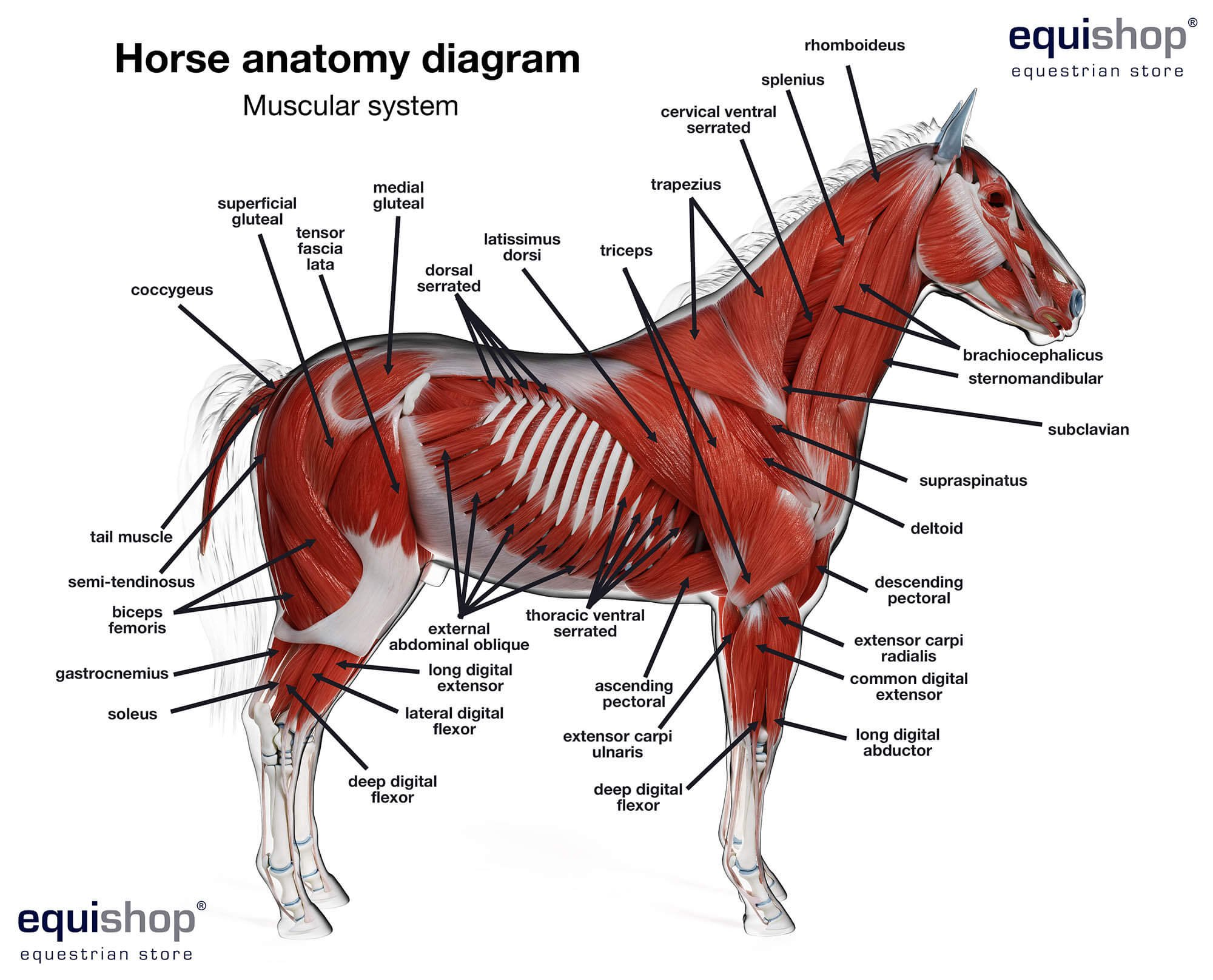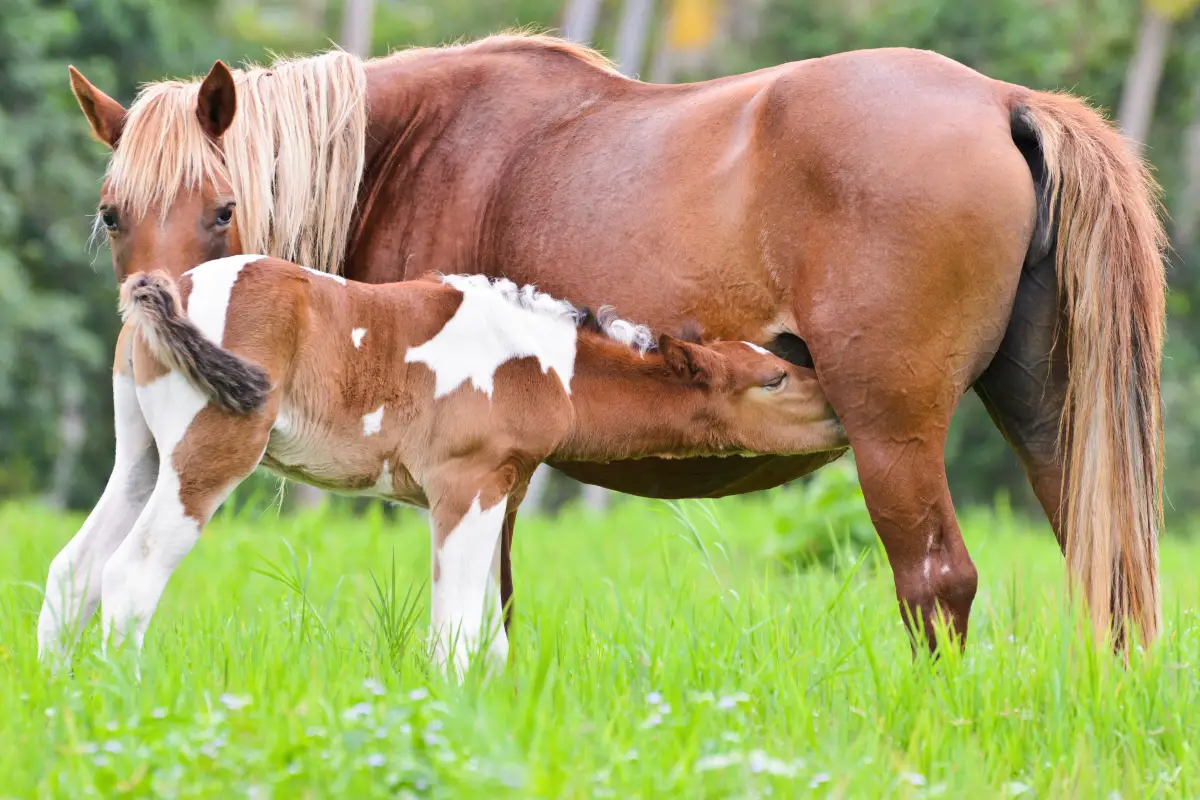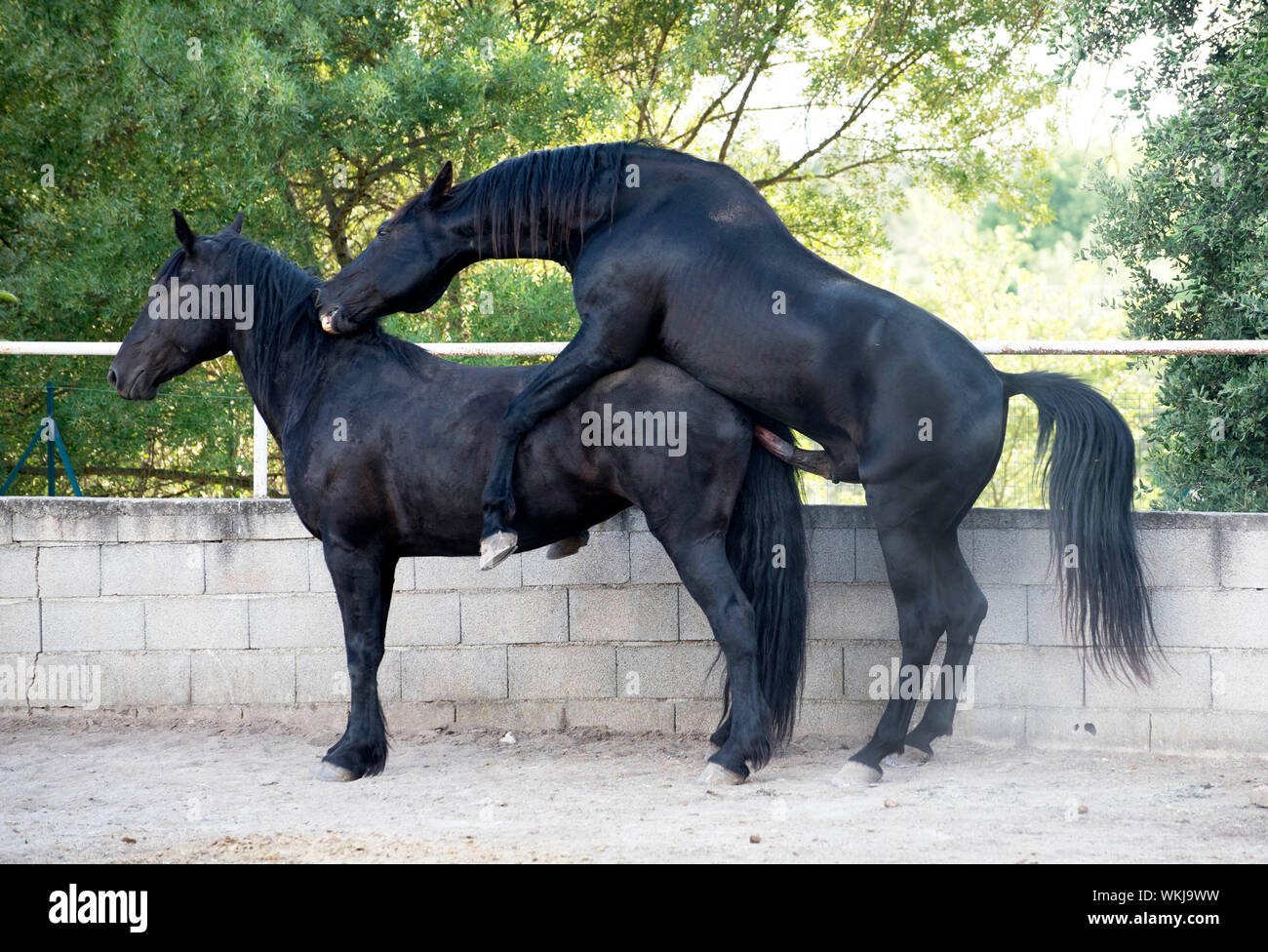Horse reproduction is a complex and fascinating process that is essential for the continuation of the equine species. Understanding the intricacies of equine reproductive anatomy, the breeding cycle of horses, and the various equine breeding practices is crucial for breeders and horse enthusiasts alike. From natural mating rituals to horse breeding techniques and the foaling process, this blog post delves into the details of how these majestic animals reproduce, manage mare fertility, and navigate the horse gestation period to ensure the birth of healthy foals.
The core of the equine sector revolves around the propagation of horses, which is vital for both maintaining the species and advancing genetic diversity. To optimize breeding outcomes, those involved in the industry must have a nuanced understanding of how equines reproduce, particularly focusing on the reproductive systems and cycles of horses. This segment aims to shed light on the journey from mating to birth, emphasizing the importance of each stage in producing future generations of these dignified creatures.
Equine reproductive systems exemplify a natural architecture fine-tuned for propagation. A closer examination reveals:
- The stallion’s reproductive machinery, though simple, is highly effective in sperm production and delivery, with the testes and penis being crucial components.
- Conversely, the mare’s system is intricate, designed for ovum production and providing a nurturing environment for the developing fetus in the uterus, with the vagina playing a dual role in semen reception and parturition.
Both male and female horses are supported by an advanced hormonal network that regulates breeding preparedness and ensures the continuity of their species.
Horses’ reproductive timing is influenced by environmental factors, particularly daylight fluctuations, which signal different stages of the mare’s estrous cycle. A comprehensive understanding of these stages is essential for successful breeding management:
- During winter’s shorter days, mares experience anestrus, a period of sexual dormancy.
- As days lengthen, mares undergo a transition to the estrus phase, with inconsistent hormonal changes.
- The estrus period is the receptive phase for ovulation and mating. It’s crucial for breeders to time copulation or artificial insemination correctly during this window.
- If conception doesn’t occur, the diestrus phase follows, characterized by sexual indifference until the next cycle.
As seasonal breeders, horses align their breeding cycles with the best conditions for their progeny’s survival.
Hormones like estrogen and progesterone are essential in the mare’s cycle, with breeders and veterinarians employing various techniques to pinpoint estrus, including monitoring mare behavior, physical signs, ultrasound examinations, and signs of receptivity.
Fertility in horses can be affected by numerous factors, which are critical to consider for effective breeding strategies. These elements encompass age, health status, genetic attributes, dietary management, and stress levels. Paying close attention to these factors is vital for the success of the reproductive process and the health of future foals.
Progress in Equine Reproduction

With the continuous evolution of veterinary science and breeding approaches, equine reproduction has entered a new era where both the vitality of foals and the reproductive efficiency of broodmares are being enhanced. This progress is marked by the integration of time-honored methods with state-of-the-art techniques, revolutionizing breeders’ strategies. Among these, equine artificial insemination stands out, providing a more secure and manageable means of advancing horse lineages.
Stallion Behavior and Breeding Management
Recognizing the unique courtship displays of stallions is essential for a harmonious breeding process. These displays often include lively movements and physical demonstrations meant to attract the mare. Effective management of a stallion’s mating disposition is crucial for both the protection of the mare and the success of copulation.
Technological Advances in Mare Reproduction
Innovations such as embryo and oocyte transfer are employed to boost the reproductive potential of mares. Additionally, tailored nutrition and fitness programs are developed to support their reproductive well-being.
Genetic Selection and ART
Breeders are now using sophisticated methods to ensure genetic compatibility and diminish the incidence of inherited ailments. These methods include pedigree scrutiny and genetic testing. Furthermore, ARTs like intracytoplasmic sperm injection (ICSI) are emerging as valuable tools to surmount reproductive obstacles.
Refinement of Artificial Insemination Techniques
Artificial insemination in horses has been refined with advancements that permit exact timing of insemination and improvement of sperm viability. Cryopreservation techniques allow the preservation and global transportation of equine semen, increasing the scope of available genetic material. Additionally, the application of semen extenders and advanced sperm selection ensures the use of high-quality sperm, enhancing pregnancy success rates.
Additional Techniques in Horse Breeding
Techniques such as uterine lavage and the use of sex-sorted semen complement the process of equine artificial insemination by improving its effectiveness. Moreover, through embryo transfer, a mare can contribute her genetics without undergoing the physical strain of carrying a foal, thus preserving her health and longevity.
By integrating these sophisticated horse breeding techniques, the equine industry is witnessing an uptick in reproductive success, resulting in the birth of robust and genetically varied foals. The ongoing refinement of these practices plays a pivotal role in the long-term sustainability and enhancement of horse populations.
Navigating the Stages of Equine Birth

The birth of a foal is the climactic moment in the cycle of equine reproduction, where thorough preparation and attentive care become key to a positive outcome. It’s imperative for those involved to establish an environment conducive to the mare’s comfort and closely monitor the event to safeguard the health of the mare and the newborn foal. The successful birth of a foal and the mare’s subsequent recovery are critical factors that influence the foal’s developmental trajectory and the mare’s well-being.
Optimizing the Mare’s Foaling Environment
Key steps in preparing for the foal’s arrival include:
- Securing a tranquil and safe foaling zone to lessen stress and risk of injury.
- Providing a well-maintained stall with adequate bedding to ensure cleanliness and comfort.
- Having essential items and information on hand, such as sterilized equipment and veterinary contacts, to be ready for any exigencies.
Phases of the Foaling Sequence
The birth process is characterized by three stages, each demanding specific knowledge and actions:
- Initiation of Labor: Signs like unease and perspiration in the mare indicate the beginning of labor, requiring vigilant observation to discern the onset of this stage.
- Birth of the Foal: As labor progresses, contractions become more powerful, and the mare might recline for the delivery. The presence of the amniotic sac and the foal’s limbs and head signals the advancing stages of birth.
- Afterbirth Passage: Following the foal’s emergence, it is critical to ensure the complete discharge of the placenta to avert postnatal complications.
Postnatal Care for Mare and Foal
Post-birth care includes vital steps for the health of mare and foal:
- Monitoring the foal for life indicators such as respiration and movement is essential.
- Helping the foal to stand and nurse from the mare promotes the intake of colostrum, key for immunity.
- Checking the mare for postpartum distress or hemorrhage can preempt health issues.
Recovery and Connection Post-Foaling
After the foal’s arrival, the mare’s care is crucial:
- Providing a diet rich in nutrients assists the mare’s recuperation and milk production.
- Conducting routine veterinary evaluations can identify and treat arising health concerns promptly.
- Encouraging mare-foal bonding strengthens their maternal relationship.
Observing Foal Development
Assessing the foal’s early behaviors gives insights into its health:
- Watching for the foal’s attempts to rise soon after birth is a sign of vigor.
- Observing the foal’s suckling reflex is a positive indication of its natural instincts.
- Documenting the foal’s initial excretions, such as meconium and urine, aids in monitoring its health status.
Each step of the foaling process demands astute attention and preparedness to navigate successfully. Caretakers must be equipped with knowledge and readiness to support this inherently fragile yet wondrous event. The future of the mare and her foal, and by extension, horse reproduction and the survival of the species, are significantly shaped by the actions executed during these pivotal instances. Implementing best practices and accepting the duties of equine care are fundamental for those guiding the foaling process, reinforcing their crucial role in fostering the continuity of the equine lineage.
Insights into Equine Pregnancy

Equine pregnancy lasts about 340 days, but individual variations exist. Throughout this time, the foal experiences essential developmental phases crucial for its viability post-birth. Breeders must be well-informed and attentive during the mare’s pregnancy, observing developmental indicators to prepare for the foal’s arrival. This exploration of equine pregnancy will expand on the care necessary to support the mare and her unborn foal.
Assessing Foal Growth Within the Womb
The foal’s development includes several physiological milestones:
- With an ultrasound, the heartbeat is usually detectable by day 25, marking the beginning of cardiac activity.
- The foal’s initial movements, often around the sixth month, confirm its musculoskeletal progress.
- During the last month, the foal gets into position for birth, necessitating close monitoring by breeders.
Recognizing these stages allows breeders to verify that the pregnancy is on course and to adjust the mare’s care as needed.
Optimizing Nutrition During Pregnancy
Pregnant mares require a carefully managed diet rich in key nutrients to support both their own health and the foal’s development. Ensuring the right balance of vitamins, minerals, proteins, and calories is essential:
- Proper intake of calcium and phosphorus is key to the foal’s bone formation.
- Vitamin E and selenium contribute to muscular health, preventing conditions that could impact the foal.
- Quality forage and additional feeds are necessary for the energy needs of both mare and foal.
Collaborating with veterinary and nutritional experts helps customize a nutrition plan suited to the mare’s changing requirements.
Health Maintenance Throughout Pregnancy
Consistent health maintenance, which includes vaccinations, parasite management, and dental care, is crucial:
- Updated vaccinations help shield both mare and foal from contagious illnesses.
- Effective deworming protocols are essential to prevent parasitic infections in the foal.
- Regular dental examinations ensure the mare’s ability to process her feed efficiently, benefiting the foal’s nutrition.
Consistent veterinary care helps identify and address any health concerns early, safeguarding the pregnancy.
Physical Activity for Expectant Mares
Appropriate exercise is advantageous for the mare’s health and can contribute to a more straightforward foaling experience:
- Light exercise sustains muscle tone and circulatory health.
- Managed physical activity helps prevent excessive weight, decreasing delivery risks.
- It is important to reduce strenuous activities as the mare nears full term.
Adapting the mare’s activity level as she progresses through pregnancy is important to meet her evolving needs and those of the growing foal.
Anticipating the Arrival of the Foal
As the due date nears, preparations for foaling should include:
- Creating a calm, safe birthing environment to reduce stress and danger.
- Having a well-equipped foaling kit and emergency contacts at the ready can address unexpected issues during delivery.
Proper preparation for the birth enhances the prospects for a healthy mare and foal.
Through a deep understanding of the horse gestation period, breeders and caretakers can offer the diligent care required. Providing an optimal environment, careful nutrition, close health monitoring, and appropriate exercise lays the groundwork for welcoming a hearty and healthy new foal.
Exploring Common Questions in Equine Breeding

When exploring equine breeding, various common inquiries emerge regarding the intricacies of the process. Providing clarity on these topics can enrich one’s understanding of equine propagation and foster successful reproductive management. Below is an expanded list of frequently asked questions that touch upon diverse aspects within the captivating subject of horse breeding.
Understanding Optimal Breeding Conditions
Identifying the ideal conditions for horse breeding is contingent on a variety of environmental and biological factors:
- Natural Cycles: The lengthening daylight stimulates the mare’s reproductive system.
- Climatic Factors: Warmer weather supports higher survival rates for young foals.
- Nutritional Resources: The abundance of food aids in the nutrition of mares and their foals.
These elements, when taken into consideration, can enhance breeding results.
Risks and Management of Twin Pregnancies in Mares
While mares can carry twins, the risk to their health and the foals’ viability is considerable:
- Carrying twins can lead to pregnancy and birthing complications.
- Reducing multiple embryos to a single one is often advised to promote a healthier pregnancy.
Proactive reproductive management can reduce the occurrence of twin conceptions.
Indications of a Mare’s Healthy Gestation
Signs of a mare’s healthy gestation include:
- The mare’s abdomen should show steady growth.
- She should display typical behavior and maintain a regular appetite.
- Positive results from routine veterinary examinations are also good indicators.
Attentive care can ensure these signs are monitored and any issues are quickly addressed.
Projecting a Mare’s Expected Delivery
A mare’s estimated delivery date is calculated by adding the average gestational period to the date of conception:
- Though typically around 340 days, foaling may occur slightly before or after this period.
Historical breeding patterns of the mare can refine the estimate.
Impact of Stallion Age on Reproductive Health
The reproductive health of a stallion is affected by his age:
- Young stallions might still be developing in terms of fertility and sexual behavior.
- Stallions reach their reproductive peak during middle age.
- Advancing age can lead to a decrease in the quality and quantity of sperm.
Recognizing the influence of age helps in planning breeding strategies.
Interventions for Enhancing Mare Fertility
Various interventions can aid mares with reproductive difficulties:
- Hormonal treatments can be used to manage their reproductive cycles.
- Advanced reproductive technologies can bypass certain physical limitations.
Targeted reproductive strategies can boost the fertility prospects for these mares.
Initial Steps Following Unsuccessful Mare Conception
When a mare fails to conceive, initial steps include:
- Performing veterinary assessments to investigate potential causes.
- Analyzing the mare’s diet and management to ensure they meet reproductive needs.
These early interventions can improve the likelihood of conception in future cycles.
Significance of Nutrition in Stallion Reproductive Health
A stallion’s fertility heavily relies on a balanced diet:
- Nutritional adequacy ensures high-quality sperm production.
- Extremes in weight can disrupt a stallion’s hormonal balance and sexual drive.
Customized nutritional plans can be developed with the help of equine nutritionists to foster reproductive vitality.
Behavioral Signs of Reproductive Health in Stallions
Behavioral patterns can provide clues to a stallion’s reproductive health:
- A decline in mating interest could highlight libido issues.
- Changes in behavior during mating attempts may signal reproductive problems.
Identifying these behaviors can lead to timely and appropriate reproductive health interventions.
Through addressing these common queries, breeders and horse enthusiasts can gain detailed insights into horse breeding, thus aiding in the management of reproductive processes and contributing to the well-being and propagation of the equine species.
Horses are majestic creatures with a range of fascinating behaviors. If you’re curious about equine communication, be sure to read our insights on how horses communicate. For those interested in the athletic prowess of these animals, our article on how horses run will give you an understanding of their incredible speed and stamina. And if you’ve ever wondered about horses and their ability to navigate water, our piece on how horses swim offers an interesting look at this lesser-known aspect of horse behavior. Discover the intricate nature of these beautiful animals, from their communication cues to their reproductive habits.
Conclusion

In conclusion, horse reproduction is a sophisticated dance of anatomy, behavior, and careful management. From the initial mating to the foaling process, each step is critical to the continuation of the species. Advances in equine breeding practices, including equine artificial insemination, have enhanced the efficiency and safety of breeding. As we continue to marvel at these magnificent creatures, understanding their reproductive processes allows us to appreciate even more the miracle of life that unfolds in the birth of each foal.



